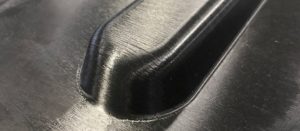
Strong, lightweight composite material for metal replacement
Canadian Plastics
MaterialsResearchers at University of Delaware’s Center for Composite Materials have developed a new high-performance material with properties equivalent to the best continuous fibre composites used in aerospace applications.

Photo Credit: University of Delaware’s Center for Composite Materials
When the acronym is pronounced “tough”, the product had better deliver.
Researchers at University of Delaware’s Center for Composite Materials (CCM) have developed a new high-performance material, known as TuFF (Tailored Universal Feedstock for Forming), with properties equivalent to the best continuous fibre composites used in aerospace applications.
And like sheet metal, TuFF can be stamped into complex shapes, opening the door for composites to replace metals in a variety of applications in the automotive, aerospace, infrastructure, electronics industries and more. Many common products, from kitchen appliances to smartphones and more, are now made with stamped sheet metal, and manufacturers might someday use TuFF instead.
Researchers at CCM started working on TuFF in 2016, when they received a US$14.9 million, three-year cooperative agreement from the Defense Advanced Research Projects Agency. The objective of the TuFF program was to develop a new composite material with properties equivalent to previously used materials, and develop a single-step manufacturing process that enables the use of the advanced materials for small parts weighing less than 20 pounds at costs competitive with aluminum. The project also included CCM faculty alumni collaborators at Clemson, Drexel, and Virginia Tech universities. Over the course of the three-year project, more than three dozen faculty, staff, and students worked on the project.
Today, CCM has a scaled pilot facility, and researchers are now conducting additional experiments, including modeling and simulation, to further understand the behavior of TuFF so that they can tailor it for more applications.
“We are going after metals at their own game,” said Jack Gillespie, director of CCM. “TuFF is low cost, can be made quickly, and is recyclable. Instead of expecting the metal manufacturers to redesign metal parts like airplanes, we decided to create a new material that can be designed and processed like metals using their existing manufacturing equipment – while still providing 40-70 per cent weight savings.”
A variety of fibres and polymers could be used to make TuFF, and the microstructure of the TuFF matrix can be tailored to each application, so there are “infinite possibilities for market growth,” Gillespie said, but also infinite opportunities for continued basic and applied research.
Source: University of Delaware
